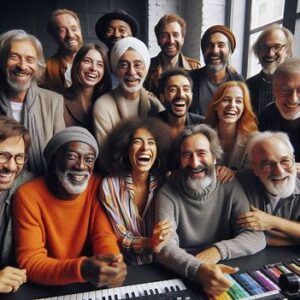I’m going to introduce you to a world where every cut and transition is a meticulous decision that transforms raw footage into compelling stories. We’re talking about film and video editing – a field that’s both an art and a technical craft. At its core, editing is about selecting and combining shots to create a coherent and emotionally engaging narrative. It’s the editor’s job to pace the storyline, ensuring that each scene flows into the next in a way that captures the audience’s attention.
You’re going to find out about the key responsibilities of film and video editors. They’re not just tech whizzes; they’re storytellers with a keen eye for detail. They work closely with directors and producers to bring a vision to life, often with the help of sophisticated editing software. But, their job isn’t just about splicing clips together; it’s about rhythm, timing, and creating a seamless experience that immerses viewers in the film.
This isn’t just about cutting scenes; it’s also about shaping the entire storyline. A skilful editor can manipulate time, build suspense, and evoke emotions. They can make you laugh, cry, or sit on the edge of your seat in anticipation, all through the power of editing. Their art is often invisible when done well, making their work a silent yet powerful contributor to the magic of cinema.
I’m here to help you understand that film and video editing is an essential part of the movie-making process. It’s more than just technical know-how; it’s about understanding human psychology, pacing, and the many elements that contribute to a successful film. So, as we explore the education and training needed to excel in this field, remember that an editor is a magician of sorts, designing the final act of a performance that shapes how a story is perceived.
Choose something that resonates with you if you’re considering a career in this field. The journey requires not only a passion for film and storytelling but also a commitment to continuous learning and an eye for detail. Let’s move toward how one acquires these skills and what educational paths can lead you to become the orchestrator of on-screen emotions.
Crafting Illusions: The Education and Training Journey
If you’re thinking about a career as a film and video editor, you’re probably wondering what kind of education and training you’ll need. Well, let me break it down for you. The path isn’t one-size-fits-all; it varies from person to person and depends on your career goals and your style of learning.
Typically, hopeful editors start with a robust foundation in film studies, communications, or a related field. Bachelor’s programs are common, offering courses in film theory, digital media, and the nuts and bolts of editing software like Adobe Premiere or Final Cut Pro. It’s not all about learning the software, though. A good program will make sure you understand the principles of storytelling, pacing, and rhythm.
More than just formal education, becoming a film and video editor often involves a good amount of hands-on experience. Many editors start with internships or editing their own projects to develop a portfolio. Practical experience is key in this industry; it’s your chance to apply what you’ve learned and start developing your own style.
Some editors choose the route of self-education. With resources like online tutorials, video courses, and community college classes, you can tailor your education to fit your needs. It’s not just about the certifications or degrees, it’s about how you use your knowledge to create compelling content.
When you’re considering education options, think about what matches your learning style and career aspirations. Do you thrive in a structured university setting, or are you more of a self-starter who prefers learning at your own pace? Whatever you choose, remember to keep building that practical experience – it’s gold in the world of film and video editing.
If you’re contemplating a career in film and video editing, you’re eyeing a path that’s as rewarding as it is demanding. This isn’t just about splicing scenes together; it’s also about weaving narrative strands into a coherent and compelling whole. Let’s explore some of the ups and downs you might encounter along the way.
When it comes to the pros, there’s a lot to get excited about. Creative satisfaction tops the list for many editors. You’ll have the opportunity to put your unique stamp on every project, turning raw footage into storytelling gold. And in today’s media-rich landscape, skilled editors are in high demand. Job opportunities range across film, television, advertising, and online content creation. Your skills can bring you into many exciting, fast-paced professional environments.
But every coin has two sides. One of the cons of this profession lies in the challenge of maintaining a work-life balance. Editing often requires long, irregular hours, especially as project deadlines approach. The job can also entail periods of intense focus and solitude which isn’t everyone’s cup of tea. Furthermore, despite the high demand for the skill set, the industry is project-based, which can mean periods of instability between gigs.
For those undeterred by the cons and ready to take on the challenges, the key is resilience and adaptability. Cultivating a strong network and consistently honing your craft can help ensure that the ebb and flow of work remains steady. In my opinion, embracing continuous learning and being open to feedback can make a monumental difference in your career trajectory.
So, what happens when you meet success in the field? You join the ranks of editors whose mastery of the craft has not only impacted individual films but also the broader art of cinema. Up next, you’re going to find out about some of these celebrated film and video editors whose work has transformed the silver screen and inspired a generation of storytellers.
Cutting to Fame:
I’m going to introduce you to some of the greatest film and video editors whose work has had a profound impact on cinema. These professionals are often unsung heroes, manipulating time and space to create narratives that captivate audiences worldwide.
Ever heard of Thelma Schoonmaker? Well, you should have. She’s been Martin Scorsese’s go-to editor for decades and has three Academy Awards under her belt. Her work includes classics like ‘Raging Bull’ and ‘The Departed’.
Don’t forget about Michael Kahn, either. This master editor’s collaboration with Steven Spielberg has resulted in some of the most memorable films in history, including ‘Schindler’s List’ and ‘Saving Private Ryan’. His expertise has earned him multiple Oscars as well.
Another trailblazer is Sally Menke, who was the editing force behind many of Quentin Tarantino’s films. Her keen eye for rhythm and timing helped shape movies like ‘Pulp Fiction’ and ‘Inglourious Basterds’. Sadly, she’s no longer with us, but her legacy in film editing continues to inspire many.
These editors have not only pushed the boundaries of storytelling through their innovative techniques and collaborations with directors but have also paved the way for future generations of film and video editors to make their mark in the industry.
As we transition into the final section, remember that the world of editing is in constant evolution. Digital technology has changed the game, and today’s editors must be adept in the latest software and trends to keep up with the fast-paced industry.
Final Frame: Summing Up the World of Film and Video Editing
So here’s where we bring everything into perspective. Film and video editing might seem like a behind-the-scenes role, but don’t be fooled; editors are crucial to filmmaking. They craft the rhythm, drive the narrative, and often make the difference between a good movie and a great one.
In the ever-changing digital era, the role of the film and video editor is evolving. Technology is advancing, bringing new tools and challenges. Editors no longer just cut and splice; they’re now storytellers, colorists, and even visual effects artists at times.
Yet, with all the tech at their fingertips, the core skills of a good editor remain the same: a keen eye for detail, impeccable timing, and the ability to see the big picture.
If you’re captivated by the idea of shaping stories, bringing characters to life, and wielding the power of the edit, then a career in film and video editing is calling your name. Choose something that resonates with you, and remember, your first attempt doesn’t need to be your last. In this field, it’s the journey—frame by frame—that counts.
I really hope that this exploration into the world of film and video editing has ignited your interest or at least provided a clearer understanding of what goes into crafting the movies and shows we love. Keep chasing those cinematic dreams, because, in editing, each cut is a new beginning.

